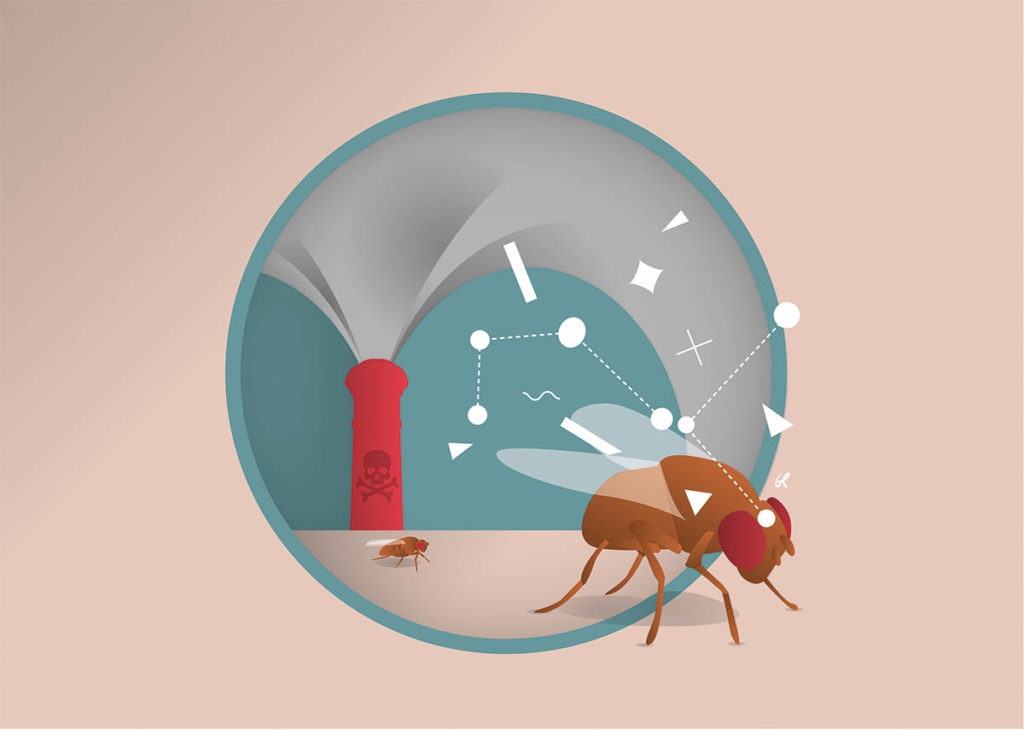Animal responses to smells can be learned or innate. The innate ability to distinguish an appetizing odor from a bad smell – that is, potentially dangerous – is essential to guide survival behaviors. From the beginning of life, animals need to be able to escape predators and find suitable food. Until now, little was known about how innate olfactory responses are programmed in the brain.
A team of neuroscientists from the Champalimaud Center (CC) in Lisbon carried out one of the first studies on the central neural circuits (or higher brain areas) underlying innate responses to smells. Its results, some of which were unexpected, were published in the magazine PLoSBiology.
Maria Luísa Vasconcelos, principal investigator at the CC's Laboratory of Innate Behavior, and her co-authors – Nélia Varela (post-doctoral), Miguel Gaspar (doctoral student) and laboratory technician Sophie Dias – addressed the issue using flies. fruit, whose olfactory system is quite similar to that of vertebrates.
In the fly's brain, a structure called the lateral horn (CL) receives information from the antennal lobe, which in turn receives sensory input from olfactory receptor neurons located in the antennae. Antennae are “the nose of the fly”, says Vasconcelos. The CL is thought to be involved in innate responses to smells.
Previous studies have shown that the structure of nerve connections from the antennal lobe to the CL is very similar from one fly to another: "in the CL, neural circuits are very stereotyped, both in terms of the number of connections and the way they branch out" , explains Vasconcelos.
In this new study, what the scientists sought was to understand the function of the CL. More precisely, to identify the CL neurons of the fly responsible for the innate aversion of this insect to the smell of carbon dioxide (CO2). “We don't know why CO2 causes such aversion”, emphasizes Vasconcelos, “but one explanation could be the fact that the flies, when they are stressed, release CO2”.
Using genetic tools, the team obtained 32 lines of genetically altered flies, in each line a particular type of CL neurons had been silenced, that is, inactivated.
To test the effect of silencing different types of neurons on the behavioral response to CO2, the scientists placed flies from each line in a “T-maze” (basically, this is a corridor that, in the end, bifurcates to the left and to on the right).
In one of the T's arms they released CO2 and in the other air. Normally, the fly always chooses to go through the air-containing arm. Therefore, if silencing a particular group of neurons abolished CO2 aversion, that fly would indifferently choose the air or CO2 arm, which would mean that these particular genetically silenced neurons were needed to elicit the aversion response. .
“We found two distinct lines of flies that lost this aversive behavior”, says Vasconcelos. First surprise: these were not the neurons scientists had been expecting. Second surprise: these two types of neurons respond specifically to CO2.
“This was unexpected,” says Vasconcelos. “We thought that their silencing would cause the loss of olfactory aversion behaviors in general, but when we tested other smells, we didn't see any change in the flies' aversion behavior to those other smells. We also tested these neurons with attractive smells and, once again, their silencing did not cause any behavioral change”.
In other words, these experiments revealed two independent sets of neurons that are needed to elicit a specific aversion response to CO2.
This is one of the main results of the study, adds Vasconcelos. Another is that one of the two types of neurons identified only have local nerve connections (ie with neurons in the CL), while the other type of neurons also projects its nerve fibers away from the CL.
Scientists also wanted to determine in which direction olfactory information circulated from one type of neuron to the other through another series of experiments. This time, they inactivated one of the two types and, at the same time, recorded the neural activity of the other type. For this they resorted to optogenetics, a technology that allows specific neurons to be turned on and off at will with the help of a laser.
They then concluded that the flow of olfactory information coming from the antennas was first processed by neurons that projected out of the CL and only later by neurons with only local connections. They thus obtained a first “picture” of the neural circuitry underlying the CO2 aversion response.
Another important result was that the group's neurons that project their nerve endings out of the CL innervate a structure in the fly's brain, called SIP (upper intermediate protocerebrum), “which is thought to coordinate learned and innate responses,” says Vasconcelos .
The researcher believes that this study on the function of the CL may serve as a guide for further studies of the neural bases of olfactory responses. As with CO2, there may be neurons specific to other smells in the CL – not just neurons that distinguish aversive from attractive smells.
“There are 1300 neurons in the fruit fly's CL, which is a lot for a fly. Things are more complex than we thought”, he concludes.
Author Champalimaud Center
Science in the Press %Regional – Ciência Viva


















Comments